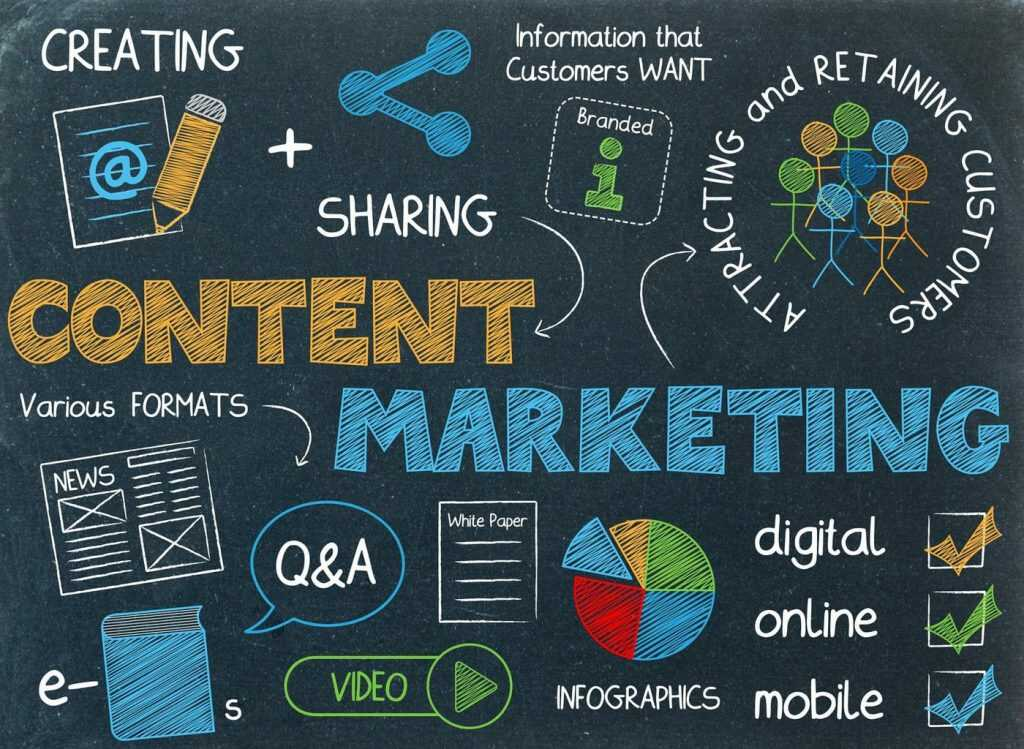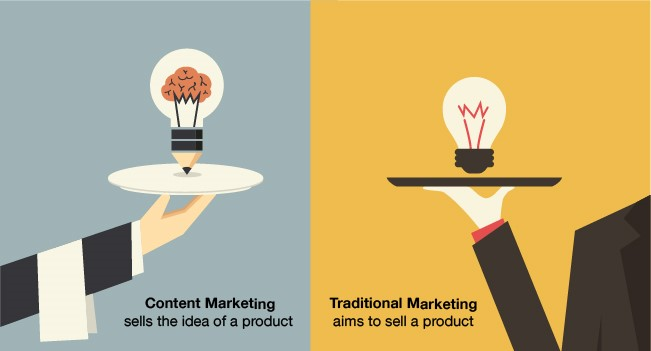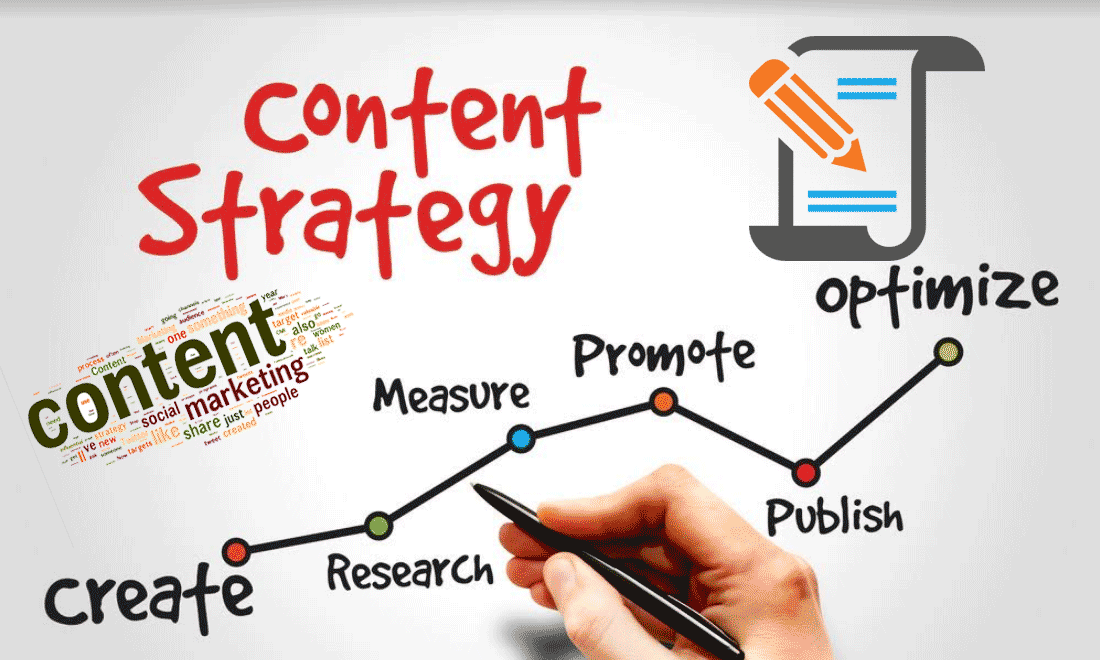What Is Content Marketing and How It Works?
 |
| What Is Content Marketing? Photo: Kdigimind |
If you are planning to open a business, it is important to understand Content Marketing and its meaning, how to operate and its advantages on helping you develop your business strategies online and on social media sites such as Facebook, Instagram, Twitter, etc. In the article below, we will explain to you what is Social Media Marketing, its advantages, and disadvantages, how to use it to promote your job and products.
Content Marketing: Definition
Content marketing is a form of marketing focused on creating, publishing, and distributing content for a targeted audience online. It is often used by businesses in order to achieve the following goals: attract attention and generate leads, expand their customer base, generate or increase online sales, increase brand awareness or credibility, and engage an online community of users. Content marketing attracts new customers by creating and sharing valuable free content. It helps companies create sustainable brand loyalty, provides valuable information to consumers, and creates a willingness to purchase products from the company in the future.
Content marketing starts with identifying the customer's needs. After that, the information can be presented in a variety of formats, including news, video, white papers, e-books, infographics, email newsletters, case studies, podcasts, how-to guides, question and answer articles, photos, blogs, etc.
Content marketing requires continuous delivery of large amounts of content, preferably within a content marketing strategy.
History of Content Marketing
 |
| Photo: Prodima |
Traditional marketers have long used content to disseminate information about a brand and build a brand's reputation. Taking advantage of technological advances in transportation and communication, business owners started to apply content marketing techniques in the late 19th century. They also attempted to build connections with their customers.
During the golden age of TV, between the 1940s and 1950s, advertising took over the media. Companies focused on sales rather than connecting with the public. There were few ventures into content marketing and not many prominent campaigns.
During the baby boom era, Kellogg's began selling sugary cereal to children. With this change in business model came sociable animal mascots, lively animated commercials, and the back of the cereal box as a form of targeted content marketing. Infographics were born in this era. This represented a new approach to making a brand memorable with the audience.
In the 1990s, everything changed for marketers. The arrival of computers and the Internet made websites and blogs flourish, and corporations found content marketing opportunities through email.
E-commerce adaptations and digital distribution became the foundation of marketing strategy.
The Internet also helped content marketing become a mainstream form of marketing. Traditional media such as newspapers, magazines, radio, and TV started to lose their power in the marketplace. Companies started to promote and sell their products digitally.
The phrase "content marketing" was used as early as 1996, when John F. Oppedahl led a roundtable for journalists at the American Society for Newspaper Editors.
In 1998, Jerrell Jimerson held the title of "director of online and content marketing" at Netscape.
In 1999, author Jeff Cannon wrote, “In content marketing, content is created to provide consumers with the information they seek.”
By the late 2000s, when social networks such as Facebook, Twitter, YouTube were born, online content marketing was accessible, shareable, and on-demand anytime worldwide.
By 2014, Forbes Magazine's website had written about the seven most popular ways companies use content marketing. In it, the columnist points out that by 2013, the use of content marketing had jumped across corporations from 60% a year or so before, to 93% as part of their overall marketing strategy. Despite the fact that 70% of organizations are creating more content, only 21% of marketers think they are successful at tracking return on investment.
Today, content marketing has become a powerful model for marketers. Storytelling is part of it, and they must convey the companies’ messages or goals to their desired audience without pushing them to just buy the product or service.
How content marketing works
 |
| Photo: Search Engine Journal |
Your business can use content marketing to attract leads, make a case for your product or service when someone is researching what to buy, and close sales.
To use it effectively, you’ll need to deliver the right content at each stage of the sales cycle—from awareness through consideration to purchase. If this sounds complicated, don’t worry: Approaching content this way actually simplifies the process.
Here’s how companies use content marketing in each stage of the sales cycle to engage and sell.
Awareness stage
At the first stage of the sales process, your content should focus on the top concerns of your audience. Writing about their pain points, challenges, and questions gives you the best chance of engaging with them. Content at the awareness stage should be educational, how-to advice. Save your selling for the consideration and closing phases.
The best content for this stage: articles, blog posts, e-books, videos, newsletters
Examples:
-A restaurant writes a blog post about how to plan a menu for a graduation party in the spring.
-A bike touring company creates a short video on the topic “3 Ways to Choose the Right Bike Trip.”
-An architecture firm creates an e-book called “Questions to Ask Before Hiring an Architect.”
Consideration stage
In the consideration stage, content should offer a hybrid of helpful information and marketing. It should educate the reader about what features or functions to look for and how various features address their needs. Of course, your content should have a bent toward what your business offers.
The best content for this stage: case studies, how-to articles, how-to videos, checklists/worksheets
Examples:
-A cloud-based phone system company creates a checklist entitled “8 Ways to Improve Your Phone Customer Service” that details the features and functions that make great customer service possible.
-A landscaping company creates case studies about “The Biggest Mistakes Most People Make When They Hire a Landscaper.”
-A catering company features case studies of successful events with a focus on the benefits they offer, such as “How to Accommodate Food Allergies at Your Next Event,” or “How to Ensure Your Caterer Uses Sustainable Practices.”
Closing stage
Content marketing plays an important role when a prospect is close to buying. At this stage, you can focus on sales, as long as you continue to drive home why you’re the best choice rather than just how great your services or products are.
Your central message here should be your expertise, knowledge, and the differentiating benefits of what you sell.
The best content for this stage: case studies, user-generated content, buyer’s guide, product video, the research report
Examples:
-A consulting firm creates a research report proving that businesses that engage in strategic planning, assessments by outsiders, and other services—shaped by what services it offers—experience higher growth.
-A design agency creates short videos showcasing the variety in its work across different industries to demonstrate its diverse expertise.
-An orthodontist practice encourages patients to contribute testimonials about its state-of-the-art equipment and top-notch service.
Why is Content Marketing important?
In the last 10 years, there has been a major shift in consumer behavior. Consumers are responding less than ever to traditional marketing, thanks to inventions like DVR and ad blockers. Smart marketers are now shifting to non-traditional marketing in response to this new trend. What makes content marketing effective, where traditional promotional content is not, is that it allows businesses to show off their expertise, and even their products, without coming off as overly promotional.
By creating content about topics that interest their target audience, businesses are able to attract new leads. Once these leads engage with their content, businesses have several ways to turn them into customers. Simply put, pushing promotional content is no longer an effective strategy. Instead, businesses now have turned into media companies, creating original content to answer their audience’s questions, solve their pain points, increase their website traffic and, ultimately, increase sales.
Content Marketing vs Traditional Marketing: What is the Difference? (according to Lander blog)
 |
| Photo: Idea Factor |
What is Traditional Marketing?
This is an interruptive marketing strategy in which advertisements or promotions for products or services reach customers whenever and wherever companies want them to.
Traditional marketing like content marketing comes in various forms; it can occur in print (magazine ads, billboards), broadcast (television ads, radio ads), and a slew of other formats (direct mailings, telemarketing, etc.).
This strategy avails the information to a wide audience of people- even when they haven’t necessarily asked to see it.
Content vs Traditional Marketing: Earned Audience vs. Rented Audience
Content audience offers something of value to its audience. The customers who discover it chooses to consume it because they choose to do so. This means that you own them- they are your audience.
On the contrary, traditional marketing strategies are seen by a “rented” audience. Traditional marketers pay money to other platforms that already have an audience to get their message viewed by a certain set of people.
Rented billboard space, purchased radio airtime, and bought PPC ads are good examples of traditional marketing.
One drawback of a rented audience is that when the campaign is complete and the rented audience cannot view your message then you no longer have a crowd of potential consumers.
Content vs Traditional Marketing: Conversation vs. One-Sided
Some strategies in traditional marketing like commercials don’t ask for an immediate response from the audience.
They provide information about the product or the service to the audience in hope that they will be motivated to buy. In contrast, content marketing is meant to start a conversation with the audience.
It is meant to engage the audience with your brand so that they can be able to trust it and eventually decide to buy it.
Content efforts that spark conversation with potential customers include things like webinars, in-person events, and many more.
Content vs Traditional Marketing: Cost
For every marketing strategy that is considered, money is the overall concern. That is however what all this is all about.
Research has shown that if you compare traditional marketing and content marketing, it is seen that content marketing is a more affordable marketing strategy.
According to a report by Demand Metric, content marketing efforts cost 62% less than traditional marketing efforts, and they generate 3x as many leads.
Content vs Traditional Marketing: Valuable information vs. Sales- Specific Information
Content marketing material offers something of value to those who consume it. It can enlighten the reader on a particular product, teach them about how to buy, or simply entertain.
On the other hand, traditional advertising tends to include only information about the product it intends to sell.
Although some methods contain some element of entertainment, their main point is to educate the audience about something that is been sold and give them information about how anyone would buy it.
Content vs Traditional Marketing: Momentum-Building vs. Steady
Content marketing is a momentum-building marketing strategy. It is difficult at first but with time it becomes easier and more successful with loyal visitors to help you build up with the brand.
Blog followings grow social media numbers tick up, and newsletter subscribers multiply.
As the co-founder of Moz, Rand Fishkin said, content marketing is a flywheel marketing strategy- it’s hard to turn the wheel at the get-go, but once it's’ already rolling, it's fast and powerful.
In contrast, traditional marketing campaigns are much steadier than content marketing campaigns.
They are released and finished with some level of effectiveness. Traditional marketing efforts don’t necessarily build upon themselves, and each campaign isn’t necessarily “easier” than the one before it.
Benefits of Content Marketing
 |
| Photo: Brandcom |
1. Establishes Your Business As A Thought Leader: Why should customers choose your business over one of your competitors? One reason is that you are an expert in your industry. This is why companies have blogs, entrepreneurs guest post for top news sites, and CEOs try to land speaking appearances. All of these things help to position the person or business as an expert, which in turn leads to trust. Content marketing is a perfect way to educate people while proving you are an expert and can be trusted.
2. Attracts New Leads: Think of your content as a giant magnet. When written well it will begin attracting potential customers (new leads). An important thing to keep in mind is the relevance of your content. If your content is attracting the wrong leads then you are wasting your time.
3. Increase Your Followers On Social Media: Content marketing and social media are a match made in heaven. You write your content and then use social media to distribute it. The leads you attract with your content will hopefully start following you on social media. The benefit of this is obvious: they will continue to see your new content when you post it to social media.
4. Improves Search Engine Optimization (SEO): Americans alone conduct 20,000,000,000 searches per month. Needless to say, search engines will play a major role in your business being found on the internet. Search engine optimization (SEO) is the process of affecting the visibility of a website or a web page in a search engine’s unpaid results. Content marketing plays an integral role in SEO. By creating content related to your industry, you increase the chances of a search engine showing your content to searchers.
5. Increases Sales: Yes, content marketing can make you money. The benefits listed above should make it clear how sales can and will increase with a well-executed content marketing strategy.
6. Cheaper Than Traditional Marketing: Digital marketing, content marketing specifically, is much cheaper than traditional marketing and generates significantly more leads.
Read More: What Is InBound & OutBound Marketing: Definition, Pros and Cons, Strategies and More
Content Marketing: Pros And Cons
1. The Pros
Cost-effective and achieve better results
Content marketing is a cost-effective method that provides you with better results than traditional marketing. You can say content marketing is suitable to modern age marketing which is customer and search engine-driven. The ROI on content marketing actually improves over time. It also helps you in a short sales cycle.
Enhance traffic and conversions
If you produce quality content, it can actually draw the audience to your website and boost your web traffic. And once the audience is on your site they will be convinced to register or make a purchase from your site.
Boost brand awareness, trust, and loyalty
Your quality contents make an impression on your brand. When you publish informative, valuable, and well-researched content, your business will be considered authoritative and trustworthy. The more your audiences rely on you for information, the more they will make a purchase from you.
Growth in SEO
When you produce quality content it directly affects your website during search engine results. And if you add content to your site on a regular basis, it shows the search engine that your website is alive, well, and active.
2. The Cons
Time-consuming
Creating good quality content always takes time. To get a higher ranking in the search engine result page on Google, you need to publish your post daily or weekly. To attract your customers, you need to spend time understanding their problems and situation. It will take time but it can hit your target audience.
Not easy to manage
Content marketing is not an easy task to manage. You need to go through a lot of research to produce relevant content for your audience. Make sure you keep them motivated with your content whenever you schedule, post or measure the results. It’s not an easy task to manage content marketing.
Required a lot of creativity and skills
Content marketing is very creative in itself. If you want to create certain infographics and videos, you need to have certain skills and creativity in you. I am not asking you to be an expert, but you need to have certain expertise in areas such as design, website development, social media, content writing, and strategic analysis.
Difficulty in finding content topics and ideas
It can be complex for you to come up with creative ideas and effective topics for your content. Every time you need to come up with new ideas that can attract your audience and make them make a purchase from your website. It can be easier if you through a lot of research and analyze the impact of the previous topic.
How to get started with content marketingContent marketing can feel overwhelming, but it doesn’t have to be. A successful content marketing campaign should be manageable and sustainable. Take these steps to get started: Identify your audience. To create content for a particular reader, you need to have a clear idea of their priorities, challenges, and preferences. If you have detailed descriptions of your various segments, choose 1 or 2 to write for. Otherwise, craft profiles of your audience members and prospects before starting. Determine the right formats. The right format corresponds with what stage of the sales cycle you’re creating content for. Another important consideration includes what formats will best help you showcase value. For some, this will be a video; for others, a checklist. Decide who will write, edit, and proofread your copy. An audience will judge your content on its quality, and they should. Identify the right resource, internal or external, to create this work. Regardless of who creates it, hire a professional proofreader to review anything before it goes out the door. Determine how you’ll distribute. Will you post content on your site, email it to people, or print it for an event? Start with “where” you know your audience is likely to be, and choose formats that make sense. For example, an article makes sense to send via an email, a checklist or worksheet can be posted on social media, and a buyer’s guide is a good follow-up to a pitch. Choose a sustainable schedule. It’s easy to make a content marketing plan that’s overly ambitious. Once you know the target readers and the formats, create a short-term (3-6 months) plan for a realistic number of content elements you can create, based on your budget and resources. Keep track of how long it takes you to create each piece of content so that you can build that time into your schedule. Follow best practices. Compelling content is clearly written, without the jargon that only you and your peers will know. It should also include how-to advice. A short, relevant, actionable piece of content is best. |
 What is Social Media Management? What is Social Media Management? Social media management tools and services are designed to make marketing easier, which ultimately increases profits, especially for small businesses. Check out this article to ... |
 Omicron Variant: Symptoms, Vaccines Efficacy and Best Ways to Avoid Omicron Variant: Symptoms, Vaccines Efficacy and Best Ways to Avoid Omicron, the new and dangerous COVID-19 variant: Symptoms and will vaccines still be effective? |
 What is The Favela Stock Exchange in Brazil? What is The Favela Stock Exchange in Brazil? Brazilian favelas (or slums) have created their own stock market, which community leaders see as a mechanism to boost local firms and attract investment from ... |
 What is Christmas: History, Meaning and Tradition Around the World What is Christmas: History, Meaning and Tradition Around the World Christmas has become an annual holiday commemorating the birth of Jesus Christ, which is celebrated on December 25. Many people, however, might be curious about ... |


























